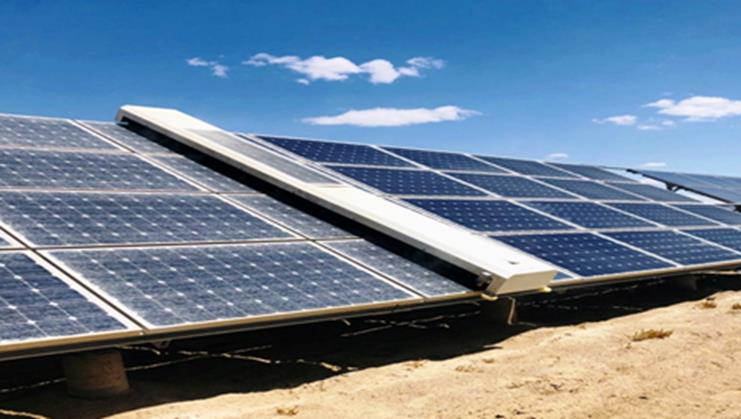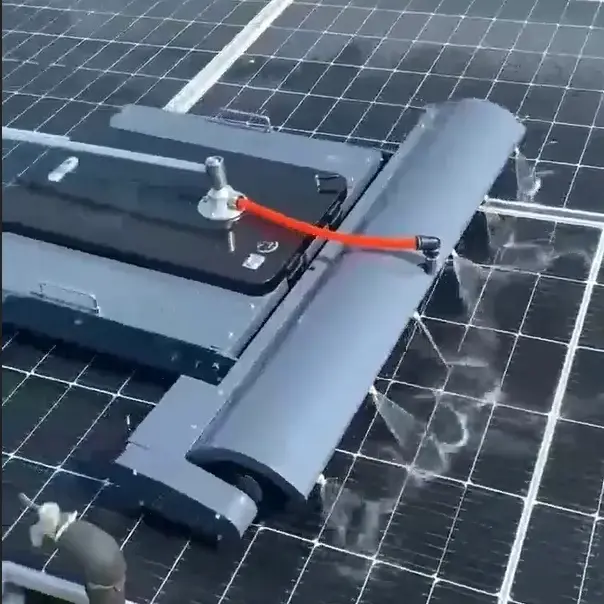The best system to clean solar panels depends on several factors, including the location of the solar panels, the type of dirt and debris accumulated, and the available resources. Here’s a detailed overview of the most common and effective systems:
Solar panels Clean system
Water-Based Cleaning Methods
- Advantages
- These methods are straightforward and widely used.
- They can remove a wide range of contaminants, including dust, bird droppings, and organic matter.
- Disadvantages
- Water-based methods are resource-intensive and not sustainable in arid regions.
- They can cause damage to the solar panels if not done carefully, leading to decreased efficiency and potential microcracks.
- Manual cleaning is labor-intensive and time-consuming, especially for large-scale installations.
- Advantages
Electrostatic Cleaning Methods
- Advantages
- Electrostatic cleaning is highly effective in removing fine dust particles.
- It does not require water, making it suitable for areas with limited water resources.
- Disadvantages
- There is a decrease in power performance after cleaning, which can be a concern for continuous operation.
- Each solar panel typically requires an individual electrostatic cleaner, making it laborious and expensive for large installations.
- Advantages
Automated Cleaning Robots
- General Advantages
- Automated cleaning robots offer high levels of automation, fast cleaning speeds, and overall efficiency.
- They can reduce the need for manual labor and improve the working environment for maintenance personnel.
- They can operate at optimal times (early morning or late night) to minimize disruptions to power generation.
- Specific Types of Robots
- Mobile Robots
- Design and Functionality
- Mobile robots are designed to move across the surface of solar panels, often using mechanical brushes or a combination of brushes and blowers.
- They can cover large areas and adapt to different terrains, making them suitable for both residential and industrial applications.
- Examples
- A design proposed for an autonomous robotic vacuum cleaner for solar panels uses a combination of a special brush and a blower to effectively remove dust without water.
- Another example is a small, lightweight dry-cleaning robot designed for solar panels, which can move freely and clean efficiently without causing damage.
- Design and Functionality
- Track-Based Robots
- Design and Functionality
- Track-based robots rely on pre-installed tracks or rails to move across the solar panels.
- They are known for their stability and high cleaning efficiency, but they require additional infrastructure and can be costly to install and maintain.
- Examples
- The Todos G3 and G4 photovoltaic station cleaning robot, which combines a robot on the panel and a ground-based transport vehicle to provide necessary resources like water and cleaning agents.
- A track-based cleaning robot developed by Xi’an Ywei Electric Technology Co., Ltd., which uses rollers on the top and bottom to move along the panels and has a high dust removal rate of 99.5%.
- Design and Functionality
- Mobile Robots
- General Advantages

- Self-Propelled Robots
- Design and Functionality
- Self-propelled robots use various adhesion methods such as thrust, magnetic adhesion, or biomimetic adhesion to stay on the panels.
- They are typically smaller and lighter, reducing the risk of damaging the panels.
- Examples
- A self-propelled cleaning robot, which uses a combination of a roller brush and cleaning agents to achieve a cleaning rate of about 100 square meters per hour.
- An intelligent solar panel cleaning robot designed to work in arid desert regions, which uses a combination of a special brush and a blower to clean without water.
- Design and Functionality
- Self-Propelled Robots

IoT-Based Solar Panel Cleaning Systems
- Advantages
- IoT-based systems can monitor the condition of solar panels in real-time and initiate cleaning automatically when needed.
- They can be controlled remotely, allowing for efficient management of multiple sites.
- They can integrate various cleaning methods, such as fans and cleaning agents, to handle different types of contaminants.
- Disadvantages
- The initial setup cost can be high due to the need for sensors, communication infrastructure, and control systems.
- They require a reliable internet connection for remote monitoring and control.
- Examples
- A system designed by researchers at Todos Institute of Technology, which uses IoT nodes to monitor dust and water accumulation on solar panels and automatically activate cleaning devices.
- The system can switch between automatic and manual modes, providing flexibility in operation.
- Advantages
Hybrid Systems
- Advantages
- Hybrid systems combine the benefits of multiple cleaning methods to optimize performance.
- They can adapt to different environments and types of contamination, making them versatile.
- Disadvantages
- They can be more complex and expensive to develop and maintain.
- Examples
- A hybrid cleaning robot that uses both a blower and a special brush to clean solar panels, achieving high efficiency and minimal water usage.
- A system that integrates both track-based and self-propelled robots to cover large areas and ensure thorough cleaning.
- Advantages
Conclusione
For large-scale installations in arid regions, automated cleaning robots that use dry cleaning methods (such as mechanical brushes or a combination of brushes and blowers) are often the best choice due to their efficiency, low water consumption, and reduced risk of damage. In residential settings, IoT-based systems can provide a convenient and flexible solution, especially when integrated with self-propelled robots. For areas where water is readily available and the panels are easily accessible, water-based cleaning methods may still be viable, but they should be used cautiously to avoid damage and inefficiency. Ultimately, the best system will depend on the specific needs and constraints of the installation site.